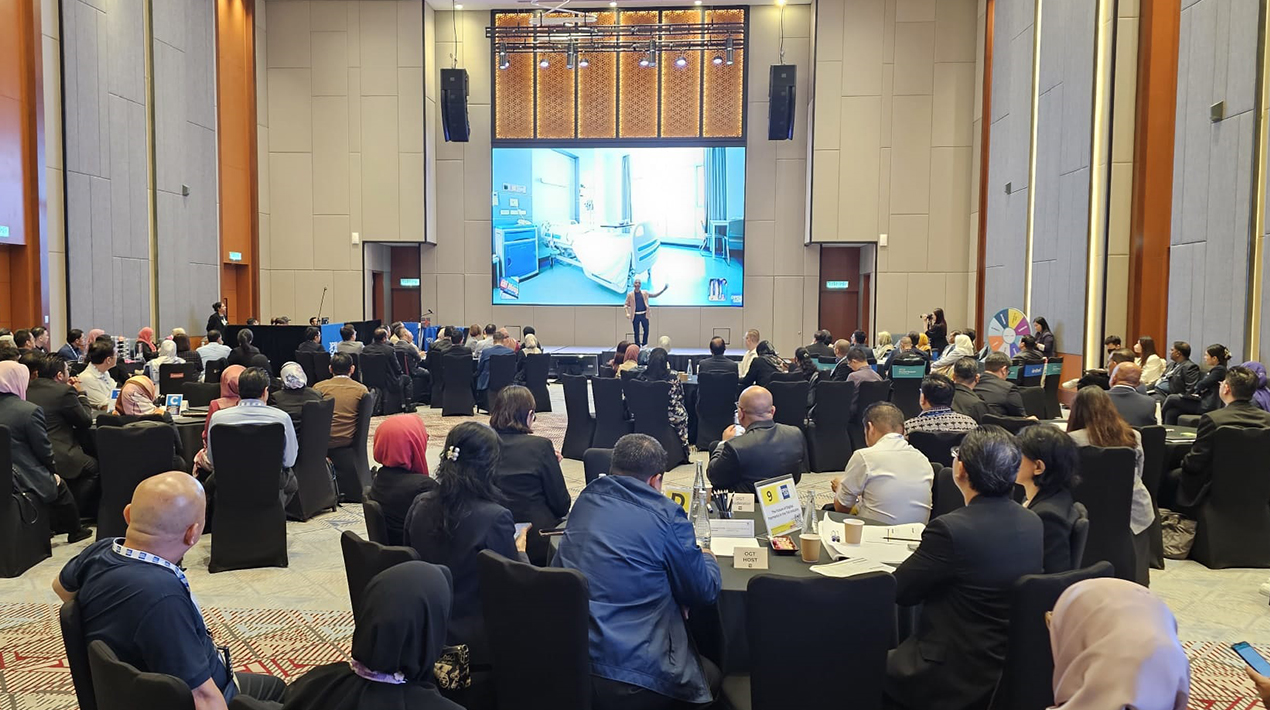
The impact of digital transformation on productivity and growth makes it a crucial undertaking for countries and organisations. Digital transformation opens up opportunities to enhance consumer experiences, develop innovative business models, and gain a competitive edge, allowing organisations to leverage technology to improve consumer engagement, achieve greater personalisation and expand their reach.
Digital transformation entails not only the adoption of new technology, but also a major change in organisational culture, procedures, and strategy. Organisations that succeed in digital transformation can optimise their operations, boost productivity and capitalise on new opportunities provided by technology.
The advantages and potential it offers have prompted Malaysia to embark on a comprehensive digital transformation journey that encompasses various sectors, stimulating economic growth and fostering an advanced digital ecosystem to stay competitive in the digital age.
Digital transformation has had a tremendous positive influence in Malaysia. The introduction of innovative technology has improved the economic sector because of digitisation. This includes extensive e-commerce, the development of digital-based apps and the transformation of effective business processes.
The reinforcement of Malaysia’s digital environment has been driven by the transformation and development of a robust digital ecosystem, supported by advanced telecommunications infrastructure, widespread internet access, and government initiatives like the National Digital Transformation Programme.
The country has prioritised investments in relevant technologies, provides digital skills training to personnel and fosters strategic collaborations with other digital stakeholders. In this environment, local organisations need to demonstrate a continuous commitment to adapt and innovate in response to the opportunities and challenges brought by digital transformation.
In the ever-changing digital environment, digital transformation is essential for organisations to gain a competitive advantage. They can accelerate growth, increase market reach and drive continuous innovation by effectively leveraging digital transformation.
The Malaysia OpenGov Leadership Forum on 22 June 2023, at the Double Tree by Hilton Putrajaya Lakeside in Malaysia, focussed on the transformation and deployment of technology in various industries to stimulate the development of Malaysia’s digital economy ecosystem.
Opening Remarks

Mohit Sagar, CEO & Editor-in-Chief of OpenGov Asia, believes the optimal deployment of appropriate technology and the effective utilisation of resources through a sustainable system can contribute to the development of robust national resilience.
Maximising organisational performance relies heavily on the optimal implementation of technology to enhance efficiency and effectiveness.
“By adopting an approach focused on using technology in the right context, organisations can better achieve their goals,” says Mohit. “Properly implemented technology can not only improve internal operations but also provide significant benefits to public services.”
It is important for organisations to allocate sufficient funds for the development and improvement of their IT systems. Investing in the right technology and infrastructure will help organisations face the complex challenges of this digital era.
In addition, upgrading IT systems also require ongoing maintenance and development, so it is necessary to allocate adequate funds to ensure smooth operations and increase technological capabilities.
Mohit knows that properly implemented technology can not only improve internal operations but also provide significant benefits to public services.
According to Mohit, public service is fundamental to national development and improving quality of life, and an ideal experience goes beyond physical infrastructure to focus on outcomes and the overall experience. As an example, in the context of a hospital, it is not just about having luxurious buildings and rooms, but rather about providing a superior patient journey.
Successful transformation is built on 6 pillars,” Mohit says. “People, Product, Process, Prioritisation, Perseverance and Partnerships play a critical role in building an effective IT operational model and assembling a successful team.”
An increasingly digital world offers organisations opportunities and challenges. On the one hand, they must embrace new technologies such as AI and machine learning to stay competitive and meet the demands of customers and society. On the other hand, organisations also face various issues related to security, compliance and data sovereignty.
To succeed in an adaptive environment, organisations must adopt a holistic approach that balances innovation and risk management. This means leveraging cloud-native architectures for AI and machine learning while implementing robust data management practices to protect sensitive information and ensure regulatory compliance.
Simultaneously, organisations need to upgrade their digital infrastructure to facilitate enhanced diversity, scalability, and sustainability. They should also adopt observability and AIOps (Artificial Intelligence for IT Operations) to enhance IT resilience.
Organisations must empower employees and citizens with the tools they need to drive innovation and digital transformation, such as low code development tools. By doing so, they can harness the power of citizen-led innovation and reimagine the future of smart citizen services through smart automation.
Digital transformation encompasses both opportunities and challenges. However, by safely embracing the latest technologies and adopting best practices, organisations can unlock new opportunities for success and effectively address the evolving needs of the world.
“To harness the full potential of technology, organisations need to proactively confront intricate risks and considerations while remaining adaptable and open to evolving in response to emerging challenges and opportunities,” Mohit concludes.
Welcome Address

Siti Sapura Binti Raffee, Principal ICT Consultant in the ICT Consultancy Division of Modernising Administration and Management Planning Malaysia (MAMPU) is convinced of the significance of integrating technology into policies to effectively address societal needs, particularly in the realm of public services.
“Digitalisation is crucial for ministries and agencies to provide digital services to citizens,” she believes. “This helps minimise physical and face-to-face transactions, as well as improve integrated and comprehensive online services.”
The Malaysian government is committed to enhancing public administration with digital technology well as integrating it for a more efficient and improved citizen experience. MAMPU, an agency operating under the Prime Minister of Malaysia, assumes a pivotal role in expediting the modernisation of administration and management within the country’s public sector.
As a digitalisation leader, MAMPU must ensure that other agencies enhance their service delivery, with a focus on integrated and inclusive “whole of government” service concepts, open government data, cybersecurity, and the adoption of innovative technology.
This is critical for improving Malaysia’s rating, particularly in the Online Services Index (OSI), which is evaluated every two years as a component of the United Nations Electronic Governance Development Index (UN-EGDI).
To realise digitisation initiatives within government institutions, Siti proposes several approaches to enhance Malaysia’s digital economy. To start, the government must be willing to invest in digital platforms that can enhance the service capabilities of the public sector.
“Investments in digital platforms will lay a solid foundation for government organisations’ digital transformation,” Siti knows. “Agencies can increase operational efficiency, speed up decision-making, and improve the quality of citizen services by establishing a stable and sophisticated digital infrastructure.”
Next, the Malaysian government should prioritise innovations that can enhance long-term public-sector policies. In an evolving digital landscape, innovation plays a crucial role in addressing challenges and seizing opportunities presented by the digital era.
One of the innovative approaches that can be implemented is the utilisation of green technology in delivering public services. By adopting environmentally friendly technologies, the government can mitigate adverse environmental impacts and contribute to the sustainable management of natural resources.
By embracing such practices, the government can contribute to a greener future while ensuring the effective delivery of services to the public. For instance, incorporating renewable energy sources into government operations and developing smart infrastructure that optimises energy consumption are concrete examples of how the government can achieve this goal.
Moreover, innovation in the implementation of e-government policies is crucial. Governments can leverage emerging technologies such as artificial intelligence and data analytics to enhance the efficiency and effectiveness of decision-making processes. By harnessing these technological advancements, governments can make more informed and data-driven decisions, ultimately improving public service delivery.
Subsequently, the government should prioritise enhancing public services through digitalisation. This can be achieved by expanding web-integrated government services, including online registration applications, electronic tax payments and digital document uploads, providing ease and convenience to the public.
Ensuring data security and protection in the delivery of digital services is another crucial aspect. During escalating cybersecurity challenges, government agencies must make the protection of individuals’ sensitive data while maintaining the security of their digital infrastructure a priority. Investing in reliable security systems and competent law enforcement will contribute to safeguarding data and fostering public trust in government digital services.
“By implementing these measures, the Malaysian government aims to achieve its objective of enhancing the digitisation of the public sector,” Siti reiterates. “Malaysia can become a regional leader by having a robust digital platform, competent workers, integrated online services and excellent data security.”
Technology Case Study

PNV Kannan, Ezmeral Lead, Growth and Emerging Markets, Hewlett Packard Enterprise discussed three key areas where the organisation is driving innovation to transform networks and generate new revenue.
The first area is Open RAN, focusing on the disaggregation of the RAN into software and hardware, offering workload-optimised infrastructure, accelerators, and tested solutions.
The second area is Telco Connected Edge, enabling B2B offers based on distributed edge computing with existing backhaul services, along with P5G and Wi-Fi connectivity.
The third area involves leveraging the connected edge platform to explore service innovation opportunities, such as IIoT, smart city, sustainability, and workplace transformation.
Kannan highlighted the significant potential of digital systems and 5G-powered use cases in reducing carbon emissions and achieving sustainability objectives. Moreover, industry analysts have provided insights on how these advancements can drive new revenue opportunities at the edge for telecom operators.
In discussing strategic themes that drive key design principles, Kanan focuses on the “Solution – Edge to Cloud Unified Data and AI platform”. This comprehensive technology solution combines edge computing and cloud computing to create a unified platform for data processing, analysis, and the application of artificial intelligence (AI) techniques.
According to Kannan, The Solution – Edge to Cloud Unified Data and AI platform offers a comprehensive approach to harnessing data and AI capabilities across the network architecture, enabling organisations to make informed decisions, drive innovation, and unlock new business opportunities.
It recognises the value of data generated at the edge of the network, where devices and sensors are located, and aims to leverage that data for insights and decision-making.
“Edge computing is a paradigm that involves processing data on local devices or edge servers, allowing for reduced latency and enabling real-time analysis,” elaborates Kannan. “On the other hand, cloud computing offers a scalable and robust infrastructure for storing and processing vast amounts of data.”
Together, these two technologies provide a powerful combination that addresses the need for both real-time processing and scalable storage and computation capabilities in modern data-driven applications. By integrating both edge and cloud computing, organisations can establish a unified data and AI platform that enables seamless data flow and analysis across the entire network architecture.
This platform allows for the collection, aggregation, and processing of data from edge devices, which can be combined with data from various other sources in the cloud. With the availability of this unified data, AI algorithms and machine learning models can be applied to gain valuable insights, make predictions and automate processes.
The benefits of the Edge to Cloud Unified Data and AI platform include real-time decision-making, reduced bandwidth and latency, scalability and flexibility, centralised management and control and enhanced ai capabilities.
The HPE GreenLake edge-to-cloud platform offers a unified on-premises cloud experience, providing capacity on-demand and consumption-based pricing for compute, memory, and storage resources, ensuring resilience, scalability, and efficiency for meeting the performance standards of the digital world.
“The HPE GreenLake edge-to-cloud platform is a powerful foundation for accelerating digital transformation by delivering cloud services that can run on-premises, at the edge, or in a colocation facility,” explains Kannan.
An automated and open cloud platform plays a crucial role in supporting banks to deliver an enhanced personalised banking experience for their customers. It provides the flexibility and scalability required to meet the evolving needs of customers. It enables banks to integrate various applications, data sources, and services, both internally and externally.
The open nature of the cloud platform also enables banks to leverage third-party applications, services, and APIs. By integrating with fintech startups, technology partners, and other financial service providers, banks can expand their offerings and provide customers with a wider range of personalised financial products and services.
“This ecosystem approach allows for innovation, agility, and the ability to quickly adapt to changing customer demands and market trends,” Kannan concludes.
Power Talk: Journey to Intelligent Data Management for the Multi-Cloud World
In a multi-cloud environment, where organisations use multiple cloud platforms for data storage and processing, intelligent data management becomes essential. Intelligent data administration refers to the implementation of advanced technologies and strategies to handle, organise, and utilise data across multiple cloud environments.

Dr Hong H. Ong, the Head of Digital Transformation and Analytics for the Malaysia Deposit Insurance Corporation Act, defines digital transformation as the utilisation of technology to enhance business processes, enhance customer experiences, and foster innovation. Conversely, analytics involves the analysis of data to extract valuable insights and facilitate informed decision-making.
Organisations can leverage the power of data to drive transformation strategies by integrating analytics into digital transformation initiatives. Analytics provides the necessary tools and techniques to analyse immense quantities of data generated throughout the digital transformation journey, enabling data-driven decision-making and revealing valuable insights to guide strategic direction.
By adding analytics to their digital transformation strategies, organisations can unlock the full potential of their data, leading to better operational efficiency, better customer experiences, and a sustainable competitive edge.
“Digital transformation and analytics complement each other by leveraging data and technology to drive organisational growth and innovation,” Dr Hong stresses. “Analytics enables data-driven decision-making, measures performance, enhances customer understanding, optimises processes, and empowers predictive and prescriptive insights.”
Data governance ensures the accuracy, dependability and consistency of data originating from various systems and sources. It establishes guidelines for data quality, determines the manner in which data is categorised and organised and enforces regulations for data validation.
Dr Hong emphasises that implementing robust data governance practices enables organisations to uphold high-quality data. This is crucial for generating valuable analytics and making reliable decisions throughout digital transformation initiatives.
Data-driven transformations and analytics heavily rely on data throughout its entire lifecycle, starting from its creation to storage and eventual deletion. Successful data management involves the implementation of effective practices for data lifecycle management, which encompasses data retention rules, data archiving, and data disposal procedures.
Proper management of data throughout its lifespan allows organisations to minimise clutter, optimise storage costs, and ensure the accuracy and relevance of data for analytics purposes. Data lifecycle management also plays a supportive role in data governance initiatives by providing a structured framework for implementing effective data management practices.
The emergence of digital technology has brought about significant transformations in the banking industry of Malaysia. It has revolutionised the way financial services are provided and has influenced how customers expect to be treated.
In the digital era, the Malaysian government and regulatory bodies have been proactive in establishing frameworks to ensure the safety of financial transactions. The Personal Data Protection Act (PDPA) and the Anti-Money Laundering Act (AMLA) impose data protection and compliance requirements on financial institutions, protecting consumer data and preventing financial crimes.

According to Tay Chia Chia, the Country Director for Veeam Malaysia, Brunei and Emerging Markets, reports indicate that expenditures on Data Protection as a Service (DPaaS) are expected to reach $18.4 billion by the year 2025. This projection highlights the growing recognition of the importance of data protection and the increasing adoption of DPaaS solutions by businesses across various industries.
In light of the current global landscape and the fact that businesses have more data than ever to protect from ransomware and cyberattacks, compliance and new regulations, and the complexities of remote working environments, she believes that the market opportunity is even greater than anticipated.
Veeam outpaces the market’s overall maturation, expanding at a much faster rate, and is firmly positioned at the centre of the data ecosystem. This, according to Chia, is a reflection of their employees and company culture, the speed of development and innovation, and the collaboration with partners to deliver solutions that exceed customer expectations and foster trust.
Veeam provides organisations with sophisticated monitoring and analytics capabilities that enable them to gain insight into their data protection infrastructure. To ensure optimal performance and resource utilisation, this includes real-time monitoring, capacity planning, and proactive alerting. By leveraging these insights, organisations can enhance their backup and recovery operations by making data-driven decisions.
Veeam’s solutions offer advantages such as comprehensive data protection, high availability, ease of use, scalability, cloud data management, data security, cost optimisation, and monitoring and analytics.
“These advantages make Veeam a valuable choice for both government and enterprise organisations seeking robust, efficient, and reliable data protection and management solutions,” Chia points out in closing.
Technology Case Study: The Journey from Cloud Chaos to Cloud Smart

Driving top-line growth through digital innovation is the process of enhancing revenue creation by utilising digital technology and methods. Businesses can tap into new markets, draw in additional customers, and offer distinctive goods or services by implementing cutting-edge digital solutions.
The creation of mobile applications, the implementation of e-commerce platforms, the use of data analytics to gain insights into the behaviour of customers, or the use of artificial intelligence in the creation of tailored marketing campaigns are examples of such projects. Organisations can grow their income, remain competitive and stand out in the market thanks to digital innovation.
Yeo Ju-Li, Cloud Solution Architect at AVM Cloud and VMware, suggests that companies can achieve long-term success by employing two interconnected methods: cost optimisation and generating top-line growth through digital innovation.
These approaches work in tandem, as cost optimisation measures create opportunities for investment in digital innovation, which, in turn, enables companies to drive top-line growth. By effectively managing costs and leveraging digital solutions, businesses can establish a sustainable foundation for success and stay competitive in the ever-evolving market.
“The constant pursuit of digital innovation while optimising costs ensures long-term growth, profitability, and adaptability to changing market conditions,” Ju-Li is convinced. “By embracing digitalisation with cost management, organisations can unlock new revenue opportunities, improve operational efficiency, and create a competitive advantage in today’s digital-first economy.”
Using a cloud operating model with a Cloud Smart strategy refers to employing cloud computing infrastructure and services as the basis for business operations. This strategy enables organisations to obtain a competitive edge in the market by leveraging the scalability, flexibility, and cost-effectiveness of cloud technology.
“One of the primary benefits of a cloud operating model is the ability to accomplish a quicker time to market. Businesses can promptly deploy and scale their applications, services, and products by utilising cloud services,” says Ju-Li.
The cloud provides a highly agile and on-demand environment, enabling organisations to respond rapidly to market demands, roll out new features or updates, and more efficiently deliver value to customers. This agility allows businesses to remain ahead of competitors and quickly seize opportunities.
To unleash the Generative AI journey, an infrastructure that is invisible and provides a solid foundation is essential. This implies that the infrastructure supporting AI-driven initiatives must be quick, responsive, scalable, secure, and resilient. Environmental, Social, and Governance (ESG) objectives require meticulous planning and implementation to be met.
To achieve ESG objectives during infrastructure construction, organisations can implement strategies such as energy efficiency, sustainable data centres, ethical AI practices, and data privacy and compliance.
“With these strategies, organisations can create an infrastructure that not only enables the journey towards Generative AI but also aligns with ESG objectives,” Ju-Li believes. “This enables AI’s full potential to be realised while minimising environmental impact, promoting social responsibility, and ensuring ethical and compliant practices.”
Acquiring, integrating and nurturing personnel is essential for operating a cloud-based smart journey that consistently delivers revenue-generating innovation at a lower cost and with greater resilience.
Organisations can effectively operate a cloud-based smart journey that offers cost optimisation, resilience, and revenue-generating innovation by focusing on recruiting and managing talented personnel.
It requires the development of a skilled workforce, the promotion of collaboration, the provision of learning opportunities, efficient management, and the alignment of personnel with the organisation’s aims and objectives.
“This holistic approach ensures a successful cloud-based journey that drives top-line growth, optimises costs and delivers continuous innovation,” concludes Ju-Li.
Get Inspired II: Cybersecurity Out Look in Malaysia 2023: Rethinking Cybersecurity in the Post-COVID-19 Era

Dato’ Ts Dr Haji Amirudin Abdul Wahab, Chief Executive Officer, CyberSecurity Malaysia highlighted that cybersecurity is becoming increasingly crucial as digital technology advances. Organisations and individuals are more vulnerable to cybersecurity attacks because of growing online engagement, and Malaysia is no exception.
“The shift of activities into the digital realm is not predominantly negative,” Dr Haji acknowledges. “The advantages provided by digital technology can easily offset concerns if everyone makes digital security a priority.”
There should be an effort made to raise awareness of the significance of cybersecurity among businesses and citizens. To improve comprehension of digital security procedures and lower the danger of cyberattacks, proper training and instruction are required.
Dr Haji shared Malaysia’s efforts in the forthcoming five-year plan and cybersecurity strategy, emphasising the National Cyber Security Policy (NCSP) as a comprehensive framework to ensure the security and resilience of Malaysia’s cyberspace. The NCSP encompasses strategies, objectives, and programs aimed at safeguarding critical information infrastructure and mitigating online threats.
“The Malaysia Cyber Security Strategy (MCSS) 2020-2024 sets out the strategic directions and priorities for Malaysia’s cybersecurity over a five-year timeframe,” Dr Haji elaborates. “This strategy’s main objectives are to develop cyber threat intelligence, build a trained cybersecurity workforce, improve cybersecurity governance, and spread cybersecurity awareness and education.”
The Malaysia Computer Emergency Response Team (MyCERT) oversees managing and responding to cybersecurity events. The team is essential in organising an incident response, offering cybersecurity advice services, and promoting best practices in cybersecurity.
The National Cyber Security Agency (NACSA) enhances cybersecurity capabilities, establishes cybersecurity standards and norms, and promotes cybersecurity awareness globally. The agency collaborates with diverse stakeholders to fulfil its mission.
In addition, the nation-specific Cybersecurity Capacity Maturity Model (CMM) framework has been implemented by Malaysia to evaluate and improve its cybersecurity capabilities. CMM offers a structured method to assess the level of cybersecurity practice maturity and pinpoint areas for development.
According to Dr Haji, Malaysia places a strong emphasis on public-private sector cooperation to improve cybersecurity. Partnerships and collaborations are fostered to promote information sharing, develop cybersecurity solutions and establish a coordinated response to cyber threats. These collaborative efforts aim to enhance cybersecurity measures and ensure a unified approach to addressing emerging challenges.
To protect national interests, the government must invest in advanced security technologies and establish stringent regulations. Additionally, strong law enforcement against cybercrime is crucial to deter attacks on digital infrastructure.
“In the post-COVID-19 era, Malaysia can effectively address cybersecurity challenges and ensure robust digital security to protect national interests and the well-being of its people,” Dr Haji concludes. “This can be achieved through a comprehensive approach and close coordination among various stakeholders.”
Get Inspired III: Aspirations of MyDIGITAL and National 4IR Policy for a Digitally Connected Malaysia

Fabian Bigar, the Chief Executive Officer of MyDIGITAL Corporation, observes that current technological advancements impacting the physical, digital, and biological realms are leading to paradigm shifts in the global economy. These breakthroughs are shaping the way the world operates and interacts in almost all sectors and domains.
The world is undergoing transformative changes due to the emergence of new technologies like automation, robots, artificial intelligence (AI), machine-to-machine communication (M2M), and the Internet of Things (IoT).
These tools have played a significant role in combating the global COVID-19 pandemic, leading to the identification of this era as the Fourth Industrial Revolution (Industry 4.0). This age is characterised by the integration of advanced technologies into various sectors, reshaping the way societies function and respond to challenges.
According to Fabian, Malaysia’s 4IR National Policy serves as a comprehensive framework that promotes balanced and sustainable socio-economic development by responsibly harnessing the power of 4IR technology. This policy aims to create harmony and synergy in leveraging the potential of advanced technologies for the country’s progress.
This policy focuses on the impact of 4IR on individuals, businesses and governments, with an emphasis on harnessing growth opportunities and addressing potential risks. By aligning with national development plans such as the 12th Malaysia Plan and the Common Prosperity Outlook 2030, this strategy aims to support the overall development of the nation while leveraging the benefits of 4IR.
“4IR drives digital progress across various sectors, accelerating the growth of the digital economy. As digitalisation strengthens, it enables the adoption of advanced technologies, fosters innovation and facilitates the emergence of new business models across all industries,” Fabian explains. “In essence, 4IR catalyses the expansion of the digital economy through the widespread utilisation of digital technologies.”
To address the challenges of the Fourth Industrial Revolution (4IR) era, Malaysia has introduced the MyDIGITAL programme. This government initiative aims to position Malaysia as a technologically advanced and highly developed nation.
The MyDIGITAL programme allows the country to adapt and respond to the changes and challenges brought about by the 4IR, ensuring that the country remains agile and well-prepared in this transformative age.
MyDIGITAL aims to drive economic growth in Malaysia by strengthening key sectors such as e-commerce, financial technology, creative industries, and other digital services. By focusing on these areas, the initiative creates investment opportunities, fosters innovation, and generates new job prospects, contributing to the overall development and prosperity of the country.
Furthermore, MyDIGITAL enhances Malaysia’s global competitiveness through the implementation of the Malaysia Digital Economy Strategy Plan. This includes initiatives to enhance the usability and effectiveness of digital technologies.
Key components of this strategy involve the development of advanced digital infrastructure, such as affordable and high-speed internet access, as well as the utilisation of cutting-edge technologies like artificial intelligence (AI), big data analytics, and the Internet of Things (IoT).
These efforts contribute to creating a digitally empowered environment that propels Malaysia’s competitiveness on the global stage. By using cutting technology to its fullest potential, businesses will be able to run more efficiently, come up with better products, and give customers a better experience.
MyDIGITAL will prioritise the development of competent human resources in digital technology, focusing on providing relevant training and education tailored to the requirements of the Fourth Industrial Revolution (4IR). By equipping the workforce with the necessary skills, Malaysia aims to ensure that its human capital is prepared to tackle challenges and maximise the opportunities presented by the digital age.
Fabian is convinced that with the support of MyDIGITAL, Malaysia has the potential to establish itself as a hub for technology and innovation within the region and to emerge as a formidable competitor in the global digital economy.
“The concerted efforts driven by MyDIGITAL can position Malaysia as a leading player in the digital landscape, making citizens’ lives better and contributing to the nation’s economic growth and recognition in the international arena,” Fabian concludes.
Technology Case Study: Reliable Cloud Data Management for Improved Service Delivery

In an increasingly data-driven and interconnected world, organisations can optimise their service delivery processes, enhance customer experiences, and drive business development by leveraging the benefits of cloud-based data management.
Dependable cloud data management enhances service delivery by ensuring data accessibility, scalability, security, compliance, integration, analytics, collaboration and innovation.
Enhancing accountability and transparency is crucial in addressing issues of trust. Building public confidence is essential for fostering a stable society and a thriving economy. As the public and private sectors collect, store, and utilise vast amounts of people’s data on a global scale, both real and perceived risks can significantly affect them.
According to Anand Ramamoorthy, APAC Director and Solutions Specialist at Informatica, the adoption of contemporary approaches in active data governance and data management brings forth a wide array of advantages. These include elevated data quality, enhanced data compliance, efficient data security measures, seamless data integration, and improved interoperability.
“These advantages empower organisations to harness the full potential of their data, make informed decisions, and drive business success in the digital era,” Anand feels.
Effective data governance and administration provide a solid foundation for data analytics and insight generation. By assuring data quality, data consistency, and data lineage, organisations can have confidence in the analytics data they use. This results in more precise, trustworthy, and actionable insights, which support data-driven decision-making, predictive analytics, and business intelligence initiatives.
Organisations can unlock the potential for data-driven innovation by investigating modern approaches to active data governance and data management. A well-governed and managed data environment provides a firm foundation for investigating advanced analytics techniques, machine learning, and AI applications.
Anand believes this promotes innovation, reveals new business opportunities, and gives organisations a competitive advantage.”
Data innovation facilitates predictive analytics models that can aid in the identification of patterns and trends in public service sectors such as healthcare, transportation, and crime prevention. By utilising historical and real-time data, governments can allocate resources proactively, implement preventative measures, and address potential problems before they escalate.
According to Anand, in the public sector, data innovation promotes transparency and accountability. Citizens can gain insight into government operations, budgets, and performance metrics by making data accessible to the public through open data initiatives. This inspires confidence, encourages public participation and ensures accountability in the delivery of public services.
“Data innovation enables BFSI institutions to collect and analyse customer data for personalising services,” Anand says. “By leveraging consumer insights, financial institutions can provide individualised product suggestions, personalised offers, and customised experiences, thereby boosting customer satisfaction and loyalty.”
In the BFSI industry, data innovation improves risk assessment and underwriting processes. By utilising sophisticated analytics and alternative data sources, financial institutions can make more precise risk assessments, determine appropriate pricing, and enhance the efficacy of their underwriting processes.
By providing data agility, scalability, collaboration, advanced analytics capabilities, cost optimisation, data security, and disaster recovery, hybrid cloud environments facilitate data innovation within organisations.
“By leveraging the benefits of a hybrid cloud, businesses can drive data-driven innovation, derive actionable insights and accelerate their digital transformation journey,” Anand concludes.
Get Inspired IV: Malaysia’s Next Leap Forward: A Nation Driven by Science, Technology, Innovation and Economy

According to Hazami Habib, Chief Executive Officer of the Academy of Sciences Malaysia, Science, Technology, Engineering, and Mathematics (STEM) education in Malaysia has garnered substantial attention and support in recent years.
The education industry must be taken into account to build a digital economy. The sector will be key to making sure that the next generation is ready to face the future and help the country stay strong.
To achieve the objectives of Industry 4.0 and reduce inequality, the Malaysian government has implemented incentives and development programmes with a specific emphasis on the education sector.
These initiatives aim to ensure that Industry 4.0 is seamlessly integrated into the country’s framework from the outset, enabling equitable participation and access to the benefits of technological advancements.
“The Malaysian government has recognised the significance of STEM education in equipping young individuals for the future workforce and propelling the country’s progress in the fields of science and technology,” Hazami confirms.
In Malaysia, a STEM-based curriculum and STEM training for teachers was put in place by the Ministry of Education to underpin STEM education. Classes, courses, programmes and projects were added to schools to get students more interested in and skilled in the field.
These initiatives involve the establishment of STEM clubs and competitions to enhance students’ engagement in STEM and equip them with the necessary skills for future careers in related fields.
Hazami highlights the significance of utilising science, engineering, technology and innovative ideas to empower individuals in nation-building and improve the overall quality of life. In this context, it is critically important to effectively use factual information to drive informed decision-making and shape policies that can lead to positive outcomes for society.
In the current landscape, organisations require people who possess strong data literacy skills as data-driven decision-making becomes increasingly prevalent. This necessitates providing opportunities for workers to enhance their data skills through learning and development initiatives.
“By cultivating a solid understanding of science and data, individuals can effectively analyse and interpret data, enabling them to make informed decisions that contribute to national, organisational and personal success,” Hazami is convinced.
The significance of STEM education and data-driven decision-making represents a paradigm shift in the application of technology. Previously, the emphasis primarily rested on the advancement of science. Current thinking enables a balanced approach that leverages technology while maintaining a strong ethical and cultural foundation within society.
STEM education policies and the use of data in decision-making in Malaysia are important for meeting the goals of sustainable economic growth and improving the quality of life for people. Adopting a science- and data-based approach facilitates a harmonious integration of technology, addressing societal challenges and upholding ethical and cultural values.
Integrating STEM education into the school curriculum offers youth valuable opportunities to learn through problem-solving, critical thinking, teamwork, and creativity. This methodology equips students with skills that are highly relevant to the demands of Industry 4.0.
“STEM learning also helps develop important mental traits, such as perseverance, thoroughness, grit, and a willingness to work hard,” Hazami feels.
By emphasising these aspects, students develop a versatile skill set that prepares them to navigate the challenges and complexities of the digital era, enabling them to thrive in an evolving and technologically-driven world.
In an ever-changing world, students proficient in STEM are encouraged to embrace innovation and drive change. They are equipped with the skills to think critically, approach problem-solving creatively, nurture their curiosity, and tackle challenging tasks with determination.
This mindset empowers them to generate new ideas, take initiative and make a tangible impact in their endeavours, preparing them to thrive in dynamic environments and shape the future through their ingenuity.
Malaysia is actively equipping its young population to navigate the rapid pace of modern advancements by prioritising STEM education. By fostering a strong foundation in STEM disciplines and cultivating data literacy skills, the nation aims to develop a workforce that is skilled, innovative, and agile in adapting to the demands of the digital age and emerging technologies.
“This strategic focus enables Malaysia to nurture a skilled workforce capable of embracing technological advancements,” Hazami concludes. “ “It will help the country move towards a sustainable knowledge-based society and maintain its edge in the digital era.”
Get Inspired V

According to Kang Yew Jin, the Chief Technology Officer of PLUS, the organisation’s vital services play a crucial role in the nation’s transportation infrastructure and development, fostering seamless connectivity and contributing to national progress.
With a sprawling motorway network spanning 1,130 kilometres, PLUS serves as a vital link, connecting major cities and towns across Malaysia and playing a crucial role in facilitating transportation and connectivity throughout the country.
In managing Malaysia’s main highways, PLUS plays a crucial role in the country’s economic growth. The motorway network, which provides a high-speed, dependable and secure mode of transportation, reduces travel time and improves connectivity between major cities and small towns, which is essential for national development.
By providing a dependable and effective transportation infrastructure, PLUS facilitates the nationwide flow of goods and people. This, in turn, supports businesses and commercial activities, considerably contributing to the economic growth and development of Malaysia.
The extensive use of technology to increase productivity and safety is one of PLUS’s most revolutionary features. AI technology enables the development of sophisticated systems capable of identifying potential suicide attempt warning signals and taking prompt, appropriate action. These systems can be outfitted with a variety of sensors, such as audio and video cameras, to monitor road traffic and identify suicidal tendencies.
Yew Jin clarifies that the purpose of the Penang Bridge AI system is to facilitate early detection and prevention of suicide attempts, which could save lives and contribute to public safety. This proactive approach allows for prompt intervention and the implementation of appropriate measures to prevent damage and ensure the safety of individuals on the Penang Bridge.
Utilising advanced technology and surveillance mechanisms, the system seeks to detect early warning signs of potential suicide attempts and alert the appropriate authorities without delay.
“The method employs strategically placed cameras along the bridge to monitor the area and detect potential suicide attempts, Yew Jin explains. “The AI system analyses live video feeds from the cameras in real-time using machine learning algorithms.”
The AI system identifies prospective suicide attempts with a high degree of sensitivity and specificity, ensuring its accuracy and dependability. Additionally, the system is designed to be expandable, enabling its extension to additional areas as required and the installation of additional cameras to enhance surveillance capabilities.
This adaptability ensures that the system can effectively respond to changing requirements and provide comprehensive protection for the safety and well-being of individuals in various locations.
The AI system installed on the Penang Bridge includes three alarm levels that are activated when the system detects specific stimuli.
- Low level (Alarm 1) – This will be triggered when a vehicle is stationary by the shoulder or the lay-by of the bridge. Vehicles detected include motorcycles, cars, vans, buses, trucks/lorries. An alert will be sent if the vehicle is stationary for more than 10 seconds.
- Medium level (Alarm 2) – This will be triggered when 1 or more people walk within the lay-by. An alert will be sent if the person is in the frame for 10 seconds. Another alert will be sent if the person remains in the frame after 30 seconds.
- High level (Alarm 3) – Triggered when one or more individuals are in close proximity to the bridge parapet, exhibiting behaviours such as placing hands on the edge, leaning over, or attempting to climb the parapet. Upon detecting such situations, an immediate alert is generated and sent to the relevant authorities.
Improving and optimising the performance of the AI system designed to detect suicide attempts on the Penang Bridge is the next crucial step. This entails performing routine maintenance and implementing required upgrades to ensure the system operates with the utmost degree of precision and dependability.
AI systems have the extraordinary ability to continuously learn and adapt to real-world conditions. As such, Yew Jin believes that the future of artificial intelligence in roadways will be characterised by its dynamic and constant evolution.
He is confident that future generations will reap the benefits of AI-powered transport systems that are increasingly efficient, secure, and sustainable, as a result of ongoing research and innovation efforts.
Power Talk: Smarter Solutions for the Workforce

Ts Tengku Intan Narqiah Tengku Othman, the Group Chief Future Officer at SIRIM Berhad, emphasises the importance of providing employees with extensive training in technology and digital systems utilised within the organisation.
She believes that employees who possess adeptness in utilising digital tools and platforms are likely to exhibit heightened productivity and efficiency, resulting in improved output within shorter timeframes. Additionally, such employees will be capable of leveraging the diverse features and functionalities offered by cutting-edge technology to enhance work processes and effectively address emerging challenges.
“Appropriate use of technology for employees can strengthen roles and performance in the workplace,” Tengku Intan is convinced. “This makes them more focused on doing more important things so that they will produce efficient and measurable performance.”
The success of remote work not only demonstrates the potential of technology but also demonstrates the importance of trust in the relationship between employers and employees. By adopting the latest tools and solutions, organisations can increase their flexibility and scalability while ensuring that collaboration remains easy and accessible from anywhere.
Centralised data security assumes a crucial role in this transformation process. As remote work becomes more prevalent, organisations are increasingly embracing centralised systems and platforms that enable employees to work efficiently without being hindered by geographical limitations.
In a digitally connected work environment, the protection of sensitive data is critical to protect businesses from security threats and financial loss that can arise. Organisations must maintain data security by adopting strong SOPs and using appropriate technology.
Such centralised approaches ensure that data is securely stored and accessible, promoting seamless collaboration and productivity across diverse locations.
Active monitoring of the network and application environment is necessary to identify and mitigate security threats. Deploying an advanced network security solution and a strong firewall can safeguard data against malware attacks, DDoS attacks, and hacking endeavours. Machine learning algorithms can detect patterns and anomalies in network traffic, enabling real-time identification and resolution of potential cyber threats.
Apart from productivity, data security is one of the top concerns for businesses in today’s digital landscape and by adopting a comprehensive approach to data security, organisations can establish a secure base for remote work, enabling employees to work with confidence while protecting critical business information.
“This approach also promotes trust among employees, as they feel confident that their data and contributions are valued and protected,” Tengku Intan concludes.

Dr Azlan Zainal, Head of Underwriting Excellence at AIA Group, notes that the rise in employee productivity directly influences the organisation’s capacity to deliver optimal service to consumers. This is because employees can spend more time with consumers and understand their needs better.
“Engaging in personal interactions allows employees to gain a deeper understanding of customers, thereby enabling them to offer tailored solutions that align with individual needs,” Dr Azlan says. “This personalised approach facilitates the provision of comprehensive advice and ensures a satisfying customer experience.”
Moreover, by creating a positive impression on customers, organisations can maintain competitiveness and enhance long-term sustainability. Therefore, a targeted technological transformation not only yields significant value but also contributes to ongoing success in the market.
By implementing precise technological changes, organisations can enhance their business processes, enabling employees to dedicate their efforts to tasks that demand creative and strategic thinking. Consequently, this enhances both productivity and the overall quality of work.
By achieving improved efficiency, fostering innovation, and gaining a competitive advantage, organisations can attain sustainable growth, elevate customer satisfaction, and solidify their position in an ever more competitive marketplace.

Ts Jacky Cheong, Head of Enterprise Data Governance (EDG) at CelcomDigi, stressed the importance of employing scalable and integrated tools and infrastructure when establishing an organisation with a hybrid system.
“Integrated data is a very important component for every organisation,” says Ts Jacky. “A hybrid approach combines both on-premises and cloud-based solutions to optimise performance, flexibility, and cost-effectiveness.”
By utilising scalable tools and infrastructure, businesses can easily adapt to changing demands and effectively manage their resources. Integration of systems ensures seamless communication and data flow between different components, enabling efficient operations and decision-making.
“The use of scalable and integrated tools and infrastructure in a hybrid organisation empowers businesses to maximise their potential and stay competitive in today’s dynamic and rapidly evolving digital landscape,” Ts Jacky is confident.
Data integration encompasses multiple facets, including data governance, data implementation and the data collection process. In organisations with varied systems and platforms, it becomes crucial to establish efficient mechanisms for consolidating data from these diverse sources.
“By carrying out good data integration, organisations can ensure the consistency, accuracy and reliability of data used in decision-making,” Ts Jacky concludes.

Anderson Goh, Business Development Manager at Lenovo, recognises that the pandemic has demonstrated the ability and necessity for companies to trust their employees to remain productive regardless of location or time.
“The pandemic has suddenly presented new challenges for companies around the world, which have been forced to adopt remote work in response to this unexpected situation,” Anderson emphasises.
The rapid advancements in technology, particularly in online communication and collaboration, have eliminated the requirement for employees to be physically present in the office to perform their tasks. Consequently, work flexibility and mobility have become paramount.
Despite initial scepticism from many organisations regarding the productivity of employees working from home or remote locations, the reality has shown otherwise. Numerous companies have witnessed unexpected surges in productivity during this period of remote work.
Post-pandemic data indicates that approximately 74% of employees in Malaysia express a preference for adopting a hybrid work model. Hybrid work entails a system wherein employees have the flexibility to work both from home and the office, adhering to the guidelines established by their respective organisations.
“Armed with the right technology and strong trust, employees can complete their tasks efficiently, collaborate virtually, and produce the expected results,” Anderson concludes.
Get Inspired VI

Brett Aimers, Adjunct Associate Professor, James Cook University, Australia acknowledges that the current understanding of disaster prevention and management struggles to keep up with the evolving challenges and complexities nowadays. Traditional approaches to disaster management frequently emphasised reactive responses and containment measures after the occurrence of a disaster.
“The unprecedented global impact of the COVID-19 pandemic has served as a wake-up call, highlighting the need to reevaluate and rewrite the framework for disaster management,” says Brett.
The pandemic showed that proactive measures, early detection and swift response are essential for mitigating the effects of disasters. This paradigm transition requires a proactive and futuristic approach to disaster prevention and management.
Brett notes that big data and analytics have emerged as indispensable instruments for fostering resilience and promoting economic recovery. Massive amounts of data generated by a variety of sources, including social media, sensor networks, and digital platforms, can provide valuable insights and early warning signals.
“By analysing this data with sophisticated analytics techniques, decision-makers can identify patterns, predict potential disasters, and devise effective strategies to prevent or mitigate their effects,” Brett explains.
Moreover, big data and analytics can contribute to post-disaster economic recovery efforts. Using data-driven insights, governments, organisations, and communities can prioritise resources, allocate funding, and implement targeted interventions to support affected regions and industries.
Decision-making based on data enables a more effective allocation of resources, ensuring that aid reaches those who require it most and thereby accelerating the recovery process.
However, the development of comprehensive and collaborative disaster management strategies is hampered by limited financial resources, political uncertainty, and global conflicts. To address these challenges, international cooperation and collaboration must be fostered.
Sharing information, best practices and expertise between nations and organisations can improve the collective understanding and response to natural disasters. Collaboration can result in the creation of standardised frameworks, protocols and tools that facilitate effective disaster prevention, preparedness, response, and recovery across international borders.
According to Brett, governments and stakeholders must recognise the significance of investing in disaster management capabilities. This includes investing in education, training and awareness programmes in addition to technology and infrastructure. Individuals, communities, and organisations must be equipped with the knowledge, skills, and resources necessary to effectively prevent, respond to, and recover from disasters to foster a resilient society.
Effective global risk management requires data and analytics. These tools enable decision-makers to gain valuable insights, recognise patterns, anticipate potential risks, and devise risk mitigation and response strategies.
“Data and analytics enable organisations and policymakers to make informed decisions, allocate resources effectively, and develop proactive responses to the challenges posed by a variety of global risks,” Brett reiterates.
Leadership based on data is crucial for mitigating impacts and enhancing mitigation efforts, thereby enhancing economic resilience. This is accomplished through a variety of means, including enhanced detection capabilities, early warnings, shared situational awareness, optimal communication, and efficient resource allocation.
By utilising data and analytics, leaders can make informed decisions, minimise the impact of potential risks and ensure a prompt and effective response to challenges. This data-driven strategy enables organisations to optimise their operations, improve their preparedness, and mitigate risks more efficiently, thereby contributing to their overall resilience and success.
Brett believes that leadership is crucial to driving the digital transformation of Malaysia. Effective Leadership provides vision, establishes strategic direction, formulates policies, facilitates collaboration, develops talent, manages change and encourages innovation and entrepreneurship.
“Strong leadership will be vital in guiding Malaysia to navigate the digital landscape, seize opportunities, tackle challenges, and propel the nation towards a future of digital empowerment,” Brett concludes.
Closing Remarks
Mohit expressed his gratitude to all the attendees who made the event valuable and congratulated the recipients of the OpenGov Recognition of Excellence Awards.
Mohit highlighted the significance of collaborating with digital partners to cultivate a culture of innovation and agility. Digital partnerships enable businesses to tap into new customer segments and markets.
Through the strategic combination of resources and capabilities, organisations have the opportunity to provide comprehensive solutions that effectively cater to a broader spectrum of customer needs. This approach not only enables increased market penetration but also fosters sustainable growth.
Digital partnerships can enhance the customer experience by integrating complementary products, services, or technologies. By combining the strengths of multiple partners, organisations can deliver seamless and personalised experiences that exceed customer expectations.
Collaboration allows organisations to share risks and costs associated with digital transformation initiatives. By pooling resources and expertise, businesses can reduce the financial burden and minimise the risks associated with technology adoption and implementation.
Digital partnerships enable organisations to adapt quickly to changing market dynamics and customer preferences. By leveraging the capabilities of digital partners, businesses can respond swiftly to evolving trends, market disruptions, and emerging customer needs, ensuring their long-term sustainability and relevance.
“By harnessing the expertise of partners, organisations can expedite the development and implementation of state-of-the-art digital solutions. Collaboration offers greater scope and safety, ultimately reducing time-to-market and maintaining a competitive edge,” Mohit concludes.
















